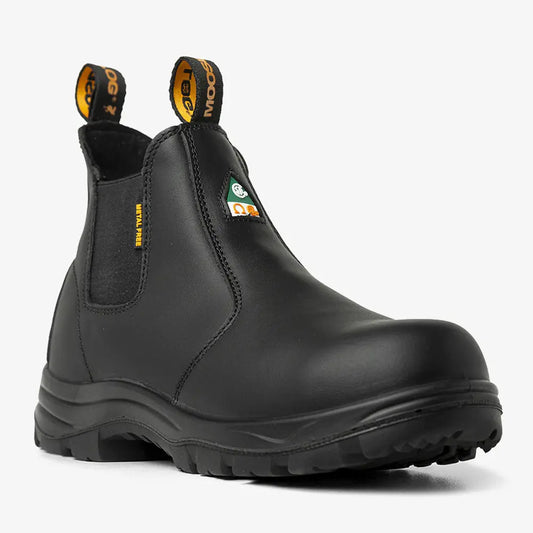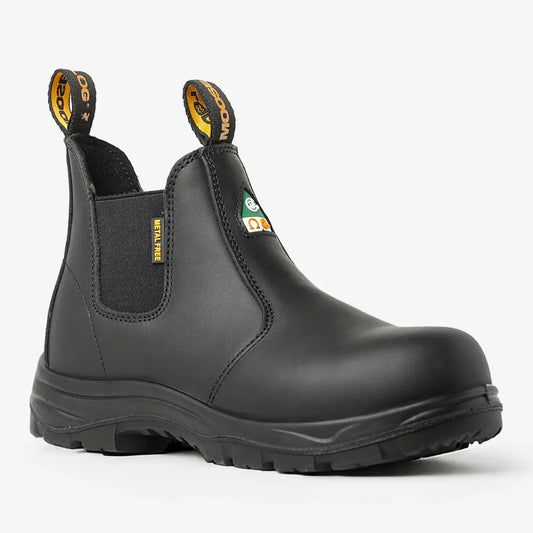
How to Prevent Blisters from Your Work Boots: 8 Proven Tips
Blisters can derail a workday faster than a stripped bolt. Once that raw spot starts forming, every step becomes a reminder of poor fit, bad socks, or just boots that aren’t broken in yet. If you’ve ever had to limp through the rest of your shift or wrap your heel with electrical tape just to finish the day, you know exactly how small problems turn into big ones.
The good news is that most blisters can be prevented with a few simple adjustments. It takes a mix of good gear, small habits, and a little patience during break-in. Once you dial these in, your boots start to work with you, solid, dependable, and built for your pace.
1. Choose the Right Socks

Socks are the first line of defence between your foot and your boot. Cotton may feel soft, but it holds onto sweat. Once moisture builds, friction follows, and friction is what causes skin to break.
Wool or moisture-wicking synthetic socks do the opposite. They draw sweat away from your skin and let air move through the fabric. Wool also regulates temperature, keeping your feet cool in summer and warm in winter.
If you’re breaking in new boots, try a thicker pair of wool socks for the first few days. They create padding that protects your skin while the leather loosens and shapes around your foot. Many workers keep several pairs of wool socks in rotation to avoid washing them out too often, since over-washing can break down the fibers.
2. Add a Liner Sock
A liner sock is a lightweight, tight-fitting layer that sits under your main pair. It absorbs early moisture and reduces the direct contact between your skin and your boot. This is especially helpful on long shifts or in hot environments.
The liner creates a controlled layer of movement, meaning the rubbing happens between your socks, not between your sock and your foot. Nylon or polyester liners work best because they’re thin, smooth, and fast-drying. Combine a liner with a quality wool work sock, and you’ll notice a major drop in blisters during the break-in period.
3. Stretch New Boots Before the Job
Every boot needs time to adjust. Leather, even when it’s top-grade, starts stiff. If you go straight from box to jobsite, you’re asking for friction.
Before the first full day in new boots, stretch them out. Use a boot stretcher overnight or wear them at home for short periods with thick socks. Move around in them to let the leather start flexing.
Boot stretchers also help widen the toe area slightly for those with broad feet, reducing pressure that leads to rubbing around the pinky toe and forefoot. A boot that bends and breathes naturally follows your stride and keeps your skin intact.
4. Use Tongue Pads or Insoles
If your heel lifts when you walk, friction forms near the back of the boot. If your arch feels unsupported, your foot slides forward and your toes start rubbing. Both of these issues come from small gaps inside the boot that can be fixed with minor adjustments.
Tongue pads fill extra space over the top of your foot, locking your heel in place and stopping movement that leads to hot spots. Insoles with proper arch support help distribute pressure evenly, which also keeps your feet from sliding inside the boot.
For workers who spend most of the day walking, lifting, or climbing ladders, these small upgrades can make the difference between sore feet and steady comfort.
5. Break Them In Gradually
Breaking in new boots should be a process, not an event. Start slow. Wear your new pair for a few hours a day, then switch back to your old boots once you start feeling tightness or rubbing. After a few days, increase the wear time until your feet feel natural inside them.
Leather molds with heat, moisture, and pressure. The more controlled that process is, the more evenly it forms around your foot. Rushing it means hot spots, bruised toes, and unnecessary pain. Workers who take time to break in their boots properly usually get longer life and a better fit overall.
6. Keep Your Feet Dry
Moisture is one of the biggest causes of blisters, especially when temperatures rise or you’re working indoors. Damp skin softens and becomes more vulnerable to friction.
Sprinkle a small amount of cornstarch or specialized foot powder inside your socks before putting on your boots. These absorb sweat and help your feet stay dry longer. Antifungal powders can also help if you work in wet conditions often.
Rotate your socks throughout the day if needed. A quick change during lunch is often enough to prevent that clammy feeling and the rubbing that comes with it.
7. Focus on Fit
No trick can replace proper fit. Always measure your foot length and width before buying new work boots. Your toes need about a quarter inch of space at the front. Your heel should stay locked in without slipping, but still feel comfortable through the arch.
If you’re between sizes, go with the size that fits your heel snugly and leaves room for socks. Pressure on your toes means the boot is too small. Constant movement at the heel means it’s too big.
Every brand fits differently, so use size charts carefully and, if possible, try boots on at the end of the day when your feet are slightly swollen. That’s when you’ll get the truest sense of fit for long shifts.
8. Rest and Elevate During Breaks
Standing for ten hours straight takes a toll. Swelling increases pressure inside your boots, which adds friction where you least expect it.
Whenever you get a break, take a few minutes to elevate your feet. Rest them on a box, a chair, or anything raised off the ground. This lowers blood flow to your feet temporarily, easing the swelling and letting your skin recover before you go back to work.
Simple steps like this make a big difference when you’re on your feet day after day.
The MooseLog Difference

Every MooseLog boot is built with materials that help your feet stay dry, cool, and blister-free. The upper uses top-grade full-grain leather, chosen for its strength, breathability, and ability to shape naturally to your foot over time. Full-grain leather allows air to move through while resisting surface cracking, which keeps the boot flexible through long hours of wear.
Inside, a soft moisture-wicking lining draws sweat away from your skin and helps maintain a stable temperature. The BigZone™ composite toe provides roomy protection without forcing your toes together.
All MooseLog boots are CSA Z195 and ASTM F2413 certified, built to handle impact, compression, and electrical hazard risks while maintaining the comfort needed for long shifts. Designed in Toronto and tested across Canadian worksites, MooseLog safety boots protect your feet from both jobsite hazards and the everyday friction that causes blisters.
Final Takeaway
Blisters are easy to avoid once you understand what causes them. Choose socks that manage moisture, stretch your boots before the job, break them in gradually, and keep your feet dry. A few minutes of care at the start of each day prevents hours of discomfort later.
If your current boots leave you dealing with sore spots or friction, it might be time for a better build.
FAQ: Preventing Blisters from Work Boots
1. Why do work boots cause blisters?
Blisters form when friction, heat, and moisture combine. Poor fit, stiff leather, or damp socks cause your skin to rub against the inside of the boot until it breaks.
2. What socks are best for preventing blisters?
Wool or moisture-wicking synthetic socks are best. They move sweat away from your skin and reduce friction. Avoid cotton socks since they trap moisture.
3. How long does it take to break in new work boots?
It usually takes about a week of gradual wear. Start with a few hours a day, then increase the time as the leather softens and molds to your feet.
4. Can tight boots cause blisters?
Yes. Tight boots create pressure points that rub with every step. Always leave a small amount of toe room and ensure your heel stays secure without pinching.
5. How can I make new boots more comfortable?
Stretch them before the first full shift, wear quality socks, and keep your feet dry. Using tongue pads can help stop heel movement while breaking them in.
6. Do MooseLog boots help prevent blisters?
Yes. MooseLog boots use top-grade full-grain leather and breathable mesh linings that manage moisture and reduce irritation.
For more advice on new footwear, read our related posts:




